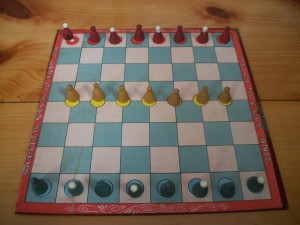 The game of Seven Sleepers was copyrighted by E.I. Horsman in 1891 and included The 24 Puzzle challenge within its directions. E.I. Horsman (Edward Imeson Horsman) first opened a toy company in 1865 and later expanded the New York City outfit to include games. “The Halma Company”, referring to E.I. Horsman, is generally known for producing the popular game of Halma in 1885.
The game of Seven Sleepers was copyrighted by E.I. Horsman in 1891 and included The 24 Puzzle challenge within its directions. E.I. Horsman (Edward Imeson Horsman) first opened a toy company in 1865 and later expanded the New York City outfit to include games. “The Halma Company”, referring to E.I. Horsman, is generally known for producing the popular game of Halma in 1885.
Although Seven Sleepers isn’t as widely remembered as Halma, it is still a very rewarding and strategic game to play. The antique game box also makes an attractive display for any game collection. On the cover, two children are depicted in their attempt to solve the 24 puzzle. The opposite corner shows a man watching two women play Seven Sleepers. Both beautifully illustrate a time from the past.
The game Seven Sleepers consists of two players competing to capture the majority of ‘seven sleepers’ and then race to occupy his opponent’s starting positions. Lasting only about 15 minutes (assuming both players don’t take too long in deciding which piece to move, or to where), the game offers players a friendly, contemplative, and quick competition.
 A specially marked 8×8 (64 squared) checkered board, indicating starting positions for the players and the spaces for the seven sleepers, provides the playing surface. Game pieces include 8 red colored pawns, 8 blue colored pawns, and 7 yellow colored pawns. The pieces of 8 belong to the two ‘active’ players and are placed on the nearest row (first row) of each player. The seven yellow are the ‘sleepers’ and are placed on middle points of the gridded board (shown on right) at the start of the game. The sleepers are to be captured by the players, during play, and taken from the board.
A specially marked 8×8 (64 squared) checkered board, indicating starting positions for the players and the spaces for the seven sleepers, provides the playing surface. Game pieces include 8 red colored pawns, 8 blue colored pawns, and 7 yellow colored pawns. The pieces of 8 belong to the two ‘active’ players and are placed on the nearest row (first row) of each player. The seven yellow are the ‘sleepers’ and are placed on middle points of the gridded board (shown on right) at the start of the game. The sleepers are to be captured by the players, during play, and taken from the board.
The game could be played today on any chess/checkerboard by noting the beginning positions of the pieces and by following the rules below. Even though the 1891 game provides pieces placed on the light squares with white colored tops, this is not necessary. It only helped to differentiate between game pieces of light or dark squares.
There are only two moves of the game:
Single move: A player may move any piece from one square to the next by moving diagonally, only. He will always remain on squares of the same color, light or dark, of which he started, all throughout the game.
Multiple move: A player may move any piece from one square to another by jumping over, one at a time, as many times, in any direction, diagonally or rectangular. Again, he will land on a square of the same color as his beginning colored square.
Once a player has crossed the central line, he cannot go back across it.
Sleepers are captured when either player jumps a yellow pawn during a single or multiple move. Since the sleepers are at junctions of the squares, they can only be captured by a diagonal movement, and not rectangular.
The object is for players to capture the majority of the sleepers, AND, then place all his men (in correct order) on the starting positions of his opponent.
The game will be considered a tie if the player without the majority of captured sleepers places his men in his opponent’s starting positions before his opponent. So, the only way a player can win is if he captures the majority and is the first to occupy his opponent’s position.
Seven Sleepers is easy to learn. However, play of the game requires careful consideration of all moves. The simplicity of moves should not suggest a chance or effortless win. Like, Camelot or Pente, (which also share simple, but in depth play), this two player game presents a challenging and enjoyable activity.

Pingback: McLoughlin Bros. 1888 Antique Game of Tri Bang » All About Fun and Games